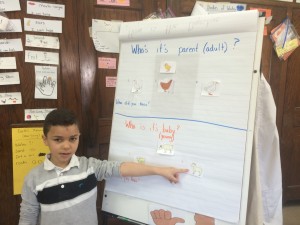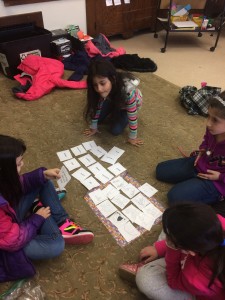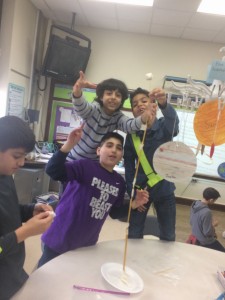Kindergarten
Content Objective: I can recognize the difference between living and nonliving things by creating a collage of magazine pictures and sorting them by living or nonliving.
Language Objective: I can orally explain at least 2 living and 2 nonliving pictures from my collage using the sentence stems:
The ___________ is living because___________.
The ____________is nonliving because_________.
Vocabulary: living, non living, survive, animals, basic needs, air, water, food, shelter
L.OL.00.11 Identify that living things have basic needs.
L.OL.00.12 Identify and compare living and nonliving things
![IMG_3339[1]](https://iblog.dearbornschools.org/gruczl/wp-content/uploads/sites/1011/2016/03/IMG_33391-300x225.jpg)
![IMG_3340[1]](https://iblog.dearbornschools.org/gruczl/wp-content/uploads/sites/1011/2016/03/IMG_33401-300x225.jpg)
First Grade
Content Objective: I can understand the daily changes in the sun’s position in the sky by observing how a shadow is formed and looks like at various times of the day.
Language Objective:
I can write and draw to explain the sun’s position affects a shadow.
Vocabulary: Sun, Earth, orbit, revolve, rotate, day, night,24 hours, shadow, background, object.
E.ES.01.11 Identify the sun as the source of warmth for the Earth
E.SS1-1 Use observations of the sun to describe predictable patterns of motion.(Compare patterns in the Earth’s rotation to observations of daily changes in the sun’s position.)
![IMG_3346[1]](https://iblog.dearbornschools.org/gruczl/wp-content/uploads/sites/1011/2016/03/IMG_33461-300x225.jpg)
![IMG_3345[1]](https://iblog.dearbornschools.org/gruczl/wp-content/uploads/sites/1011/2016/03/IMG_33451-300x225.jpg)
![IMG_3342[1]](https://iblog.dearbornschools.org/gruczl/wp-content/uploads/sites/1011/2016/03/IMG_33421-300x225.jpg)
![IMG_3341[1]](https://iblog.dearbornschools.org/gruczl/wp-content/uploads/sites/1011/2016/03/IMG_33411-300x225.jpg)
Second Grade
Content Objective: I can demonstrate comprehension of how Earth’s surface changes by building a lego landform and playing a weathering, erosion, and deposition game where each team has to weather away a piece of their lego landform, walk it (erode it) to the other side and deposit it to form a new lego landform.
*(This game shows how weathering away a rock makes it smaller and smaller, erosion is when sediment gets moved from one place to another, and deposition is when sediment gets dropped off to make a new landform).*
Language Objective: I can draw and write to explain how weathering, erosion, and deposition work to change or form landforms.
Vocabulary: landforms, bodies of water, plateaus, valleys, hills, canyons, caves, erosion, weathering, downhill, mountains, plains, deposition
E.SE.E.2 Surface Changes- The surface of Earth changes. Some changes are due to slow processes, such as erosion and weathering, and some are due to rapid changes, such as landslides, volcanic eruptions, and earthquakes.
E.SE.02.21 Describe the major landforms of the surface of Earth (mountains, plains, plateaus, valleys).
![IMG_3338[1]](https://iblog.dearbornschools.org/gruczl/wp-content/uploads/sites/1011/2016/03/IMG_33381-300x225.jpg)
![IMG_3335[1]](https://iblog.dearbornschools.org/gruczl/wp-content/uploads/sites/1011/2016/03/IMG_33351-300x225.jpg)
![IMG_3334[1]](https://iblog.dearbornschools.org/gruczl/wp-content/uploads/sites/1011/2016/03/IMG_33341-300x225.jpg)
![IMG_3332[1]](https://iblog.dearbornschools.org/gruczl/wp-content/uploads/sites/1011/2016/03/IMG_33321-300x225.jpg)
![IMG_3330[1]](https://iblog.dearbornschools.org/gruczl/wp-content/uploads/sites/1011/2016/03/IMG_33301-300x225.jpg)
![IMG_3329[1]](https://iblog.dearbornschools.org/gruczl/wp-content/uploads/sites/1011/2016/03/IMG_33291-300x225.jpg)
Third Grade
Content Objective: I can demonstrate knowledge of how animals survive and adapt to their environment exploring how color can help things blend in so that it is hard to see them (camouflage).
Language Objective: I can write to explain how camouflaging helps living things survive in their environment.
Vocabulary: observable structure, function, physical characteristics, adaptation, environment, survival, camouflage
L.OL.E.3 Structures and Functions- Organisms have different structure that serve different functions in growth, survival, and reproduction.
L.OL.03.32 Identify and compare structures in animals used for controlling body temperature, support, movement, food-getting, and protection
![IMG_3323[1]](https://iblog.dearbornschools.org/gruczl/wp-content/uploads/sites/1011/2016/03/IMG_33231-300x225.jpg)
![IMG_3321[1]](https://iblog.dearbornschools.org/gruczl/wp-content/uploads/sites/1011/2016/03/IMG_33211-300x225.jpg)
Fourth Grade- (continuation of last week)
Content Objective: I can demonstrate comprehension of the Sun, Earth, and Moon’s movements and the effects it has on us by creating a model of the movements using a flashlight(sun), Earth (globe), and styrofaom ball (moon) and using the paper cut-out I made last week.
Language Objectives: I can draw and write to explain what is happening when the Earth rotates and revolves around the sun and when the moon rotates and revolves around the Earth.
Sentence stems:
The Earth ________________ around the sun in __________causing _______ and _____________.
The Earth ____________ around the sun in __________.
The moon ____________ around the Earth in about _________ days. This give us our ___________.
Vocabulary: Sun, Earth, Moon, star, planet, orbit, solar system, rotate, revolve, year, day, night, month
E.ST.04.21 Describe the orbit of the Earth around the sun as it defines a year.
E.ST.04.22 Explain the spin of the Earth creates day and night.
E.ST.04.23 Describe the motion of the moon around the Earth.
![IMG_3318[1]](https://iblog.dearbornschools.org/gruczl/wp-content/uploads/sites/1011/2016/03/IMG_33181-300x225.jpg)
![IMG_3317[1]](https://iblog.dearbornschools.org/gruczl/wp-content/uploads/sites/1011/2016/03/IMG_33171-300x225.jpg)
Fifth Grade
Content Objective: I can demonstrate knowledge of the difference between inherited and acquired traits by identifying which traits are inherited or acquired for both animal and plants in a matching trait game.
Language Objective: I can write to explain what I learned about inherited and acquired traits.
Sentence Stems:
Inherited traits__________________.
Acquired traits____________________.
Both are important because_________________.
Vocabulary: genetic, heredity, inherited traits, acquired traits, physical characteristics
L.HE.05.12 Distinguish between inherited and acquired traits
L.HE.M.1 Inherited and Acquired Traits- The characteristics of organisms are influenced by heredity and environment. For some characteristics, inheritance is more important, for others characteristics, interactions with the environment are more important.
![IMG_3327[1]](https://iblog.dearbornschools.org/gruczl/wp-content/uploads/sites/1011/2016/03/IMG_33271-300x225.jpg)
![IMG_3326[1]](https://iblog.dearbornschools.org/gruczl/wp-content/uploads/sites/1011/2016/03/IMG_33261-300x225.jpg)
![IMG_3325[1]](https://iblog.dearbornschools.org/gruczl/wp-content/uploads/sites/1011/2016/03/IMG_33251-300x225.jpg)
![IMG_3794[1]](https://iblog.dearbornschools.org/gruczl/wp-content/uploads/sites/1011/2016/05/IMG_37941-300x225.jpg)
![IMG_3795[1]](https://iblog.dearbornschools.org/gruczl/wp-content/uploads/sites/1011/2016/05/IMG_37951-300x225.jpg)
![IMG_3796[1]](https://iblog.dearbornschools.org/gruczl/wp-content/uploads/sites/1011/2016/05/IMG_37961-300x225.jpg)
![IMG_3797[1]](https://iblog.dearbornschools.org/gruczl/wp-content/uploads/sites/1011/2016/05/IMG_37971-300x225.jpg)
![IMG_3786[1]](https://iblog.dearbornschools.org/gruczl/wp-content/uploads/sites/1011/2016/05/IMG_37861-300x225.jpg)
![IMG_3787[1]](https://iblog.dearbornschools.org/gruczl/wp-content/uploads/sites/1011/2016/05/IMG_37871-300x225.jpg)
![IMG_3788[1]](https://iblog.dearbornschools.org/gruczl/wp-content/uploads/sites/1011/2016/05/IMG_37881-300x225.jpg)
![IMG_3789[1]](https://iblog.dearbornschools.org/gruczl/wp-content/uploads/sites/1011/2016/05/IMG_37891-300x225.jpg)
![IMG_3792[1]](https://iblog.dearbornschools.org/gruczl/wp-content/uploads/sites/1011/2016/05/IMG_37921-1-300x225.jpg)
![IMG_3793[1]](https://iblog.dearbornschools.org/gruczl/wp-content/uploads/sites/1011/2016/05/IMG_37931-300x225.jpg)
![IMG_3791[1]](https://iblog.dearbornschools.org/gruczl/wp-content/uploads/sites/1011/2016/05/IMG_37911-300x225.jpg)
![IMG_3790[1]](https://iblog.dearbornschools.org/gruczl/wp-content/uploads/sites/1011/2016/05/IMG_37901-300x225.jpg)
![IMG_3776[1]](https://iblog.dearbornschools.org/gruczl/wp-content/uploads/sites/1011/2016/05/IMG_37761-300x225.jpg)
![IMG_3777[1]](https://iblog.dearbornschools.org/gruczl/wp-content/uploads/sites/1011/2016/05/IMG_37771-300x225.jpg)
![IMG_3778[1]](https://iblog.dearbornschools.org/gruczl/wp-content/uploads/sites/1011/2016/05/IMG_37781-300x225.jpg)
![IMG_3779[1]](https://iblog.dearbornschools.org/gruczl/wp-content/uploads/sites/1011/2016/05/IMG_37791-300x225.jpg)
![IMG_3780[1]](https://iblog.dearbornschools.org/gruczl/wp-content/uploads/sites/1011/2016/05/IMG_37801-300x225.jpg)
![IMG_3781[1]](https://iblog.dearbornschools.org/gruczl/wp-content/uploads/sites/1011/2016/05/IMG_37811-300x225.jpg)
![IMG_3782[1]](https://iblog.dearbornschools.org/gruczl/wp-content/uploads/sites/1011/2016/05/IMG_37821-300x225.jpg)
![IMG_3783[1]](https://iblog.dearbornschools.org/gruczl/wp-content/uploads/sites/1011/2016/05/IMG_37831-300x225.jpg)
![IMG_3784[1]](https://iblog.dearbornschools.org/gruczl/wp-content/uploads/sites/1011/2016/05/IMG_37841-300x225.jpg)
![IMG_3785[1]](https://iblog.dearbornschools.org/gruczl/wp-content/uploads/sites/1011/2016/05/IMG_37851-300x225.jpg)
![IMG_3667[1]](https://iblog.dearbornschools.org/gruczl/wp-content/uploads/sites/1011/2016/04/IMG_36671-300x225.jpg)
![IMG_3669[1]](https://iblog.dearbornschools.org/gruczl/wp-content/uploads/sites/1011/2016/04/IMG_36691-300x225.jpg)
![IMG_3671[1]](https://iblog.dearbornschools.org/gruczl/wp-content/uploads/sites/1011/2016/04/IMG_36711-300x225.jpg)
![IMG_3672[1]](https://iblog.dearbornschools.org/gruczl/wp-content/uploads/sites/1011/2016/04/IMG_36721-300x225.jpg)
![IMG_3693[1]](https://iblog.dearbornschools.org/gruczl/wp-content/uploads/sites/1011/2016/04/IMG_36931-300x225.jpg)
![IMG_3683[1]](https://iblog.dearbornschools.org/gruczl/wp-content/uploads/sites/1011/2016/04/IMG_36831-300x225.jpg)
![IMG_3685[1]](https://iblog.dearbornschools.org/gruczl/wp-content/uploads/sites/1011/2016/04/IMG_36851-300x225.jpg)
![IMG_3686[1]](https://iblog.dearbornschools.org/gruczl/wp-content/uploads/sites/1011/2016/04/IMG_36861-300x225.jpg)
![IMG_3687[1]](https://iblog.dearbornschools.org/gruczl/wp-content/uploads/sites/1011/2016/04/IMG_36871-300x225.jpg)
![IMG_3688[1]](https://iblog.dearbornschools.org/gruczl/wp-content/uploads/sites/1011/2016/04/IMG_36881-300x225.jpg)
![IMG_3689[1]](https://iblog.dearbornschools.org/gruczl/wp-content/uploads/sites/1011/2016/04/IMG_36891-300x225.jpg)
![IMG_3690[1]](https://iblog.dearbornschools.org/gruczl/wp-content/uploads/sites/1011/2016/04/IMG_36901-300x225.jpg)
![IMG_3691[1]](https://iblog.dearbornschools.org/gruczl/wp-content/uploads/sites/1011/2016/04/IMG_36911-300x225.jpg)
![IMG_3656[1]](https://iblog.dearbornschools.org/gruczl/wp-content/uploads/sites/1011/2016/04/IMG_36561-300x225.jpg)
![IMG_3658[1]](https://iblog.dearbornschools.org/gruczl/wp-content/uploads/sites/1011/2016/04/IMG_36581-300x225.jpg)
![IMG_3659[1]](https://iblog.dearbornschools.org/gruczl/wp-content/uploads/sites/1011/2016/04/IMG_36591-300x225.jpg)
![IMG_3660[1]](https://iblog.dearbornschools.org/gruczl/wp-content/uploads/sites/1011/2016/04/IMG_36601-300x225.jpg)
![IMG_3661[1]](https://iblog.dearbornschools.org/gruczl/wp-content/uploads/sites/1011/2016/04/IMG_36611-300x225.jpg)
![IMG_3662[1]](https://iblog.dearbornschools.org/gruczl/wp-content/uploads/sites/1011/2016/04/IMG_36621-300x225.jpg)
![IMG_3663[1]](https://iblog.dearbornschools.org/gruczl/wp-content/uploads/sites/1011/2016/04/IMG_36631-300x225.jpg)
![IMG_3664[1]](https://iblog.dearbornschools.org/gruczl/wp-content/uploads/sites/1011/2016/04/IMG_36641-300x225.jpg)
![IMG_3665[1]](https://iblog.dearbornschools.org/gruczl/wp-content/uploads/sites/1011/2016/04/IMG_36651-300x225.jpg)
![IMG_3666[1]](https://iblog.dearbornschools.org/gruczl/wp-content/uploads/sites/1011/2016/04/IMG_36661-300x225.jpg)
![IMG_3618[1]](https://iblog.dearbornschools.org/gruczl/wp-content/uploads/sites/1011/2016/04/IMG_36181-300x225.jpg)
![IMG_3617[1]](https://iblog.dearbornschools.org/gruczl/wp-content/uploads/sites/1011/2016/04/IMG_36171-300x225.jpg)
![IMG_3614[1]](https://iblog.dearbornschools.org/gruczl/wp-content/uploads/sites/1011/2016/04/IMG_36141-300x225.jpg)
![IMG_3613[1]](https://iblog.dearbornschools.org/gruczl/wp-content/uploads/sites/1011/2016/04/IMG_36131-300x225.jpg)

![IMG_3632[1]](https://iblog.dearbornschools.org/gruczl/wp-content/uploads/sites/1011/2016/04/IMG_36321-300x225.jpg)
![IMG_3630[1]](https://iblog.dearbornschools.org/gruczl/wp-content/uploads/sites/1011/2016/04/IMG_36301-300x225.jpg)
![IMG_3641[1]](https://iblog.dearbornschools.org/gruczl/wp-content/uploads/sites/1011/2016/04/IMG_36411-300x225.jpg)
![IMG_3639[1]](https://iblog.dearbornschools.org/gruczl/wp-content/uploads/sites/1011/2016/04/IMG_36391-300x225.jpg)
![IMG_3637[1]](https://iblog.dearbornschools.org/gruczl/wp-content/uploads/sites/1011/2016/04/IMG_36371-300x225.jpg)
![IMG_3635[1]](https://iblog.dearbornschools.org/gruczl/wp-content/uploads/sites/1011/2016/04/IMG_36351-300x225.jpg)
![IMG_3633[1]](https://iblog.dearbornschools.org/gruczl/wp-content/uploads/sites/1011/2016/04/IMG_36331-300x225.jpg)
![IMG_3603[1]](https://iblog.dearbornschools.org/gruczl/wp-content/uploads/sites/1011/2016/04/IMG_36031-300x225.jpg)
![IMG_3601[1]](https://iblog.dearbornschools.org/gruczl/wp-content/uploads/sites/1011/2016/04/IMG_36011-300x225.jpg)
![IMG_3600[1]](https://iblog.dearbornschools.org/gruczl/wp-content/uploads/sites/1011/2016/04/IMG_36001-300x225.jpg)
![IMG_3599[1]](https://iblog.dearbornschools.org/gruczl/wp-content/uploads/sites/1011/2016/04/IMG_35991-300x225.jpg)
![IMG_3598[1]](https://iblog.dearbornschools.org/gruczl/wp-content/uploads/sites/1011/2016/04/IMG_35981-300x225.jpg)
![IMG_3597[1]](https://iblog.dearbornschools.org/gruczl/wp-content/uploads/sites/1011/2016/04/IMG_35971-300x225.jpg)
![IMG_3596[1]](https://iblog.dearbornschools.org/gruczl/wp-content/uploads/sites/1011/2016/04/IMG_35961-300x225.jpg)
![IMG_3595[1]](https://iblog.dearbornschools.org/gruczl/wp-content/uploads/sites/1011/2016/04/IMG_35951-300x225.jpg)
![IMG_3593[1]](https://iblog.dearbornschools.org/gruczl/wp-content/uploads/sites/1011/2016/04/IMG_35931-300x225.jpg)
![IMG_3592[1]](https://iblog.dearbornschools.org/gruczl/wp-content/uploads/sites/1011/2016/04/IMG_35921-300x225.jpg)
![IMG_3591[1]](https://iblog.dearbornschools.org/gruczl/wp-content/uploads/sites/1011/2016/04/IMG_35911-300x300.jpg)
![IMG_3604[1]](https://iblog.dearbornschools.org/gruczl/wp-content/uploads/sites/1011/2016/04/IMG_36041-300x225.jpg)
![IMG_3605[1]](https://iblog.dearbornschools.org/gruczl/wp-content/uploads/sites/1011/2016/04/IMG_36051-300x225.jpg)
![IMG_3606[1]](https://iblog.dearbornschools.org/gruczl/wp-content/uploads/sites/1011/2016/04/IMG_36061-300x225.jpg)
![IMG_3607[1]](https://iblog.dearbornschools.org/gruczl/wp-content/uploads/sites/1011/2016/04/IMG_36071-300x225.jpg)
![IMG_3609[1]](https://iblog.dearbornschools.org/gruczl/wp-content/uploads/sites/1011/2016/04/IMG_36091-300x225.jpg)
![IMG_3610[1]](https://iblog.dearbornschools.org/gruczl/wp-content/uploads/sites/1011/2016/04/IMG_36101-300x225.jpg)
![IMG_3612[1]](https://iblog.dearbornschools.org/gruczl/wp-content/uploads/sites/1011/2016/04/IMG_36121-300x225.jpg)
![IMG_3459[1]](https://iblog.dearbornschools.org/gruczl/wp-content/uploads/sites/1011/2016/04/IMG_34591-300x225.jpg)
![IMG_3458[1]](https://iblog.dearbornschools.org/gruczl/wp-content/uploads/sites/1011/2016/04/IMG_34581-300x225.jpg)
![IMG_3457[1]](https://iblog.dearbornschools.org/gruczl/wp-content/uploads/sites/1011/2016/04/IMG_34571-300x225.jpg)
![IMG_3463[1]](https://iblog.dearbornschools.org/gruczl/wp-content/uploads/sites/1011/2016/04/IMG_34631-300x225.jpg)
![IMG_3462[1]](https://iblog.dearbornschools.org/gruczl/wp-content/uploads/sites/1011/2016/04/IMG_34621-300x225.jpg)
![IMG_3460[1]](https://iblog.dearbornschools.org/gruczl/wp-content/uploads/sites/1011/2016/04/IMG_34601-300x225.jpg)
![IMG_3448[1]](https://iblog.dearbornschools.org/gruczl/wp-content/uploads/sites/1011/2016/04/IMG_34481-300x225.jpg)
![IMG_3444[1]](https://iblog.dearbornschools.org/gruczl/wp-content/uploads/sites/1011/2016/04/IMG_34441-300x225.jpg)
![IMG_3445[1]](https://iblog.dearbornschools.org/gruczl/wp-content/uploads/sites/1011/2016/04/IMG_34451-300x225.jpg)
![IMG_3446[1]](https://iblog.dearbornschools.org/gruczl/wp-content/uploads/sites/1011/2016/04/IMG_34461-300x225.jpg)
![IMG_3456[1]](https://iblog.dearbornschools.org/gruczl/wp-content/uploads/sites/1011/2016/04/IMG_34561-300x225.jpg)
![IMG_3455[1]](https://iblog.dearbornschools.org/gruczl/wp-content/uploads/sites/1011/2016/04/IMG_34551-300x225.jpg)
![IMG_3453[1]](https://iblog.dearbornschools.org/gruczl/wp-content/uploads/sites/1011/2016/04/IMG_34531-300x225.jpg)
![IMG_3452[1]](https://iblog.dearbornschools.org/gruczl/wp-content/uploads/sites/1011/2016/04/IMG_34521-300x225.jpg)
![IMG_3450[1]](https://iblog.dearbornschools.org/gruczl/wp-content/uploads/sites/1011/2016/04/IMG_34501-300x225.jpg)
![IMG_3370[1]](https://iblog.dearbornschools.org/gruczl/wp-content/uploads/sites/1011/2016/03/IMG_33701-300x225.jpg)
![IMG_3369[1]](https://iblog.dearbornschools.org/gruczl/wp-content/uploads/sites/1011/2016/03/IMG_33691-300x225.jpg)
![IMG_3368[1]](https://iblog.dearbornschools.org/gruczl/wp-content/uploads/sites/1011/2016/03/IMG_33681-300x225.jpg)
![IMG_3385[1]](https://iblog.dearbornschools.org/gruczl/wp-content/uploads/sites/1011/2016/03/IMG_33851-300x225.jpg)
![IMG_3377[1]](https://iblog.dearbornschools.org/gruczl/wp-content/uploads/sites/1011/2016/03/IMG_33771-300x225.jpg)
![IMG_3376[1]](https://iblog.dearbornschools.org/gruczl/wp-content/uploads/sites/1011/2016/03/IMG_33761-300x225.jpg)
![IMG_3375[1]](https://iblog.dearbornschools.org/gruczl/wp-content/uploads/sites/1011/2016/03/IMG_33751-300x225.jpg)
![IMG_3392[1]](https://iblog.dearbornschools.org/gruczl/wp-content/uploads/sites/1011/2016/03/IMG_33921-300x225.jpg)
![IMG_3391[1]](https://iblog.dearbornschools.org/gruczl/wp-content/uploads/sites/1011/2016/03/IMG_33911-300x225.jpg)
![IMG_3390[1]](https://iblog.dearbornschools.org/gruczl/wp-content/uploads/sites/1011/2016/03/IMG_33901-300x225.jpg)
![IMG_3389[1]](https://iblog.dearbornschools.org/gruczl/wp-content/uploads/sites/1011/2016/03/IMG_33891-300x225.jpg)
![IMG_3388[1]](https://iblog.dearbornschools.org/gruczl/wp-content/uploads/sites/1011/2016/03/IMG_33881-300x225.jpg)
![IMG_3387[1]](https://iblog.dearbornschools.org/gruczl/wp-content/uploads/sites/1011/2016/03/IMG_33871-300x225.jpg)
![IMG_3383[1]](https://iblog.dearbornschools.org/gruczl/wp-content/uploads/sites/1011/2016/03/IMG_33831-300x225.jpg)
![IMG_3371[1]](https://iblog.dearbornschools.org/gruczl/wp-content/uploads/sites/1011/2016/03/IMG_33711-300x225.jpg)
![IMG_3358[1]](https://iblog.dearbornschools.org/gruczl/wp-content/uploads/sites/1011/2016/03/IMG_33581-300x225.jpg)
![IMG_3357[1]](https://iblog.dearbornschools.org/gruczl/wp-content/uploads/sites/1011/2016/03/IMG_33571-300x225.jpg)
![IMG_3355[1]](https://iblog.dearbornschools.org/gruczl/wp-content/uploads/sites/1011/2016/03/IMG_33551-300x225.jpg)
![IMG_3352[1]](https://iblog.dearbornschools.org/gruczl/wp-content/uploads/sites/1011/2016/03/IMG_33521-300x225.jpg)
![IMG_3353[1]](https://iblog.dearbornschools.org/gruczl/wp-content/uploads/sites/1011/2016/03/IMG_33531-300x225.jpg)
![IMG_3354[1]](https://iblog.dearbornschools.org/gruczl/wp-content/uploads/sites/1011/2016/03/IMG_33541-300x225.jpg)
![IMG_3366[1]](https://iblog.dearbornschools.org/gruczl/wp-content/uploads/sites/1011/2016/03/IMG_33661-300x225.jpg)
![IMG_3365[1]](https://iblog.dearbornschools.org/gruczl/wp-content/uploads/sites/1011/2016/03/IMG_33651-300x225.jpg)
![IMG_3364[1]](https://iblog.dearbornschools.org/gruczl/wp-content/uploads/sites/1011/2016/03/IMG_33641-300x225.jpg)
![IMG_3363[1]](https://iblog.dearbornschools.org/gruczl/wp-content/uploads/sites/1011/2016/03/IMG_33631-300x225.jpg)
![IMG_3362[1]](https://iblog.dearbornschools.org/gruczl/wp-content/uploads/sites/1011/2016/03/IMG_33621-300x225.jpg)
![IMG_3361[1]](https://iblog.dearbornschools.org/gruczl/wp-content/uploads/sites/1011/2016/03/IMG_33611-300x225.jpg)
![IMG_3339[1]](https://iblog.dearbornschools.org/gruczl/wp-content/uploads/sites/1011/2016/03/IMG_33391-300x225.jpg)
![IMG_3340[1]](https://iblog.dearbornschools.org/gruczl/wp-content/uploads/sites/1011/2016/03/IMG_33401-300x225.jpg)
![IMG_3346[1]](https://iblog.dearbornschools.org/gruczl/wp-content/uploads/sites/1011/2016/03/IMG_33461-300x225.jpg)
![IMG_3345[1]](https://iblog.dearbornschools.org/gruczl/wp-content/uploads/sites/1011/2016/03/IMG_33451-300x225.jpg)
![IMG_3342[1]](https://iblog.dearbornschools.org/gruczl/wp-content/uploads/sites/1011/2016/03/IMG_33421-300x225.jpg)
![IMG_3341[1]](https://iblog.dearbornschools.org/gruczl/wp-content/uploads/sites/1011/2016/03/IMG_33411-300x225.jpg)
![IMG_3338[1]](https://iblog.dearbornschools.org/gruczl/wp-content/uploads/sites/1011/2016/03/IMG_33381-300x225.jpg)
![IMG_3335[1]](https://iblog.dearbornschools.org/gruczl/wp-content/uploads/sites/1011/2016/03/IMG_33351-300x225.jpg)
![IMG_3334[1]](https://iblog.dearbornschools.org/gruczl/wp-content/uploads/sites/1011/2016/03/IMG_33341-300x225.jpg)
![IMG_3332[1]](https://iblog.dearbornschools.org/gruczl/wp-content/uploads/sites/1011/2016/03/IMG_33321-300x225.jpg)
![IMG_3330[1]](https://iblog.dearbornschools.org/gruczl/wp-content/uploads/sites/1011/2016/03/IMG_33301-300x225.jpg)
![IMG_3329[1]](https://iblog.dearbornschools.org/gruczl/wp-content/uploads/sites/1011/2016/03/IMG_33291-300x225.jpg)
![IMG_3323[1]](https://iblog.dearbornschools.org/gruczl/wp-content/uploads/sites/1011/2016/03/IMG_33231-300x225.jpg)
![IMG_3321[1]](https://iblog.dearbornschools.org/gruczl/wp-content/uploads/sites/1011/2016/03/IMG_33211-300x225.jpg)
![IMG_3318[1]](https://iblog.dearbornschools.org/gruczl/wp-content/uploads/sites/1011/2016/03/IMG_33181-300x225.jpg)
![IMG_3317[1]](https://iblog.dearbornschools.org/gruczl/wp-content/uploads/sites/1011/2016/03/IMG_33171-300x225.jpg)
![IMG_3327[1]](https://iblog.dearbornschools.org/gruczl/wp-content/uploads/sites/1011/2016/03/IMG_33271-300x225.jpg)
![IMG_3326[1]](https://iblog.dearbornschools.org/gruczl/wp-content/uploads/sites/1011/2016/03/IMG_33261-300x225.jpg)
![IMG_3325[1]](https://iblog.dearbornschools.org/gruczl/wp-content/uploads/sites/1011/2016/03/IMG_33251-300x225.jpg)
![IMG_3284[1]](https://iblog.dearbornschools.org/gruczl/wp-content/uploads/sites/1011/2016/03/IMG_32841-300x225.jpg)
![IMG_3279[1]](https://iblog.dearbornschools.org/gruczl/wp-content/uploads/sites/1011/2016/03/IMG_32791-300x225.jpg)
![IMG_3276[1]](https://iblog.dearbornschools.org/gruczl/wp-content/uploads/sites/1011/2016/03/IMG_32761-300x225.jpg)
![IMG_3274[1]](https://iblog.dearbornschools.org/gruczl/wp-content/uploads/sites/1011/2016/03/IMG_32741-300x225.jpg)
![IMG_3273[1]](https://iblog.dearbornschools.org/gruczl/wp-content/uploads/sites/1011/2016/03/IMG_32731-300x225.jpg)
![IMG_3272[1]](https://iblog.dearbornschools.org/gruczl/wp-content/uploads/sites/1011/2016/03/IMG_32721-300x225.jpg)
![IMG_3271[1]](https://iblog.dearbornschools.org/gruczl/wp-content/uploads/sites/1011/2016/03/IMG_32711-300x225.jpg)
![IMG_3310[1]](https://iblog.dearbornschools.org/gruczl/wp-content/uploads/sites/1011/2016/03/IMG_33101-300x225.jpg)
![IMG_3312[1]](https://iblog.dearbornschools.org/gruczl/wp-content/uploads/sites/1011/2016/03/IMG_33121-300x225.jpg)
![IMG_3311[1]](https://iblog.dearbornschools.org/gruczl/wp-content/uploads/sites/1011/2016/03/IMG_33111-300x225.jpg)
![IMG_3302[1]](https://iblog.dearbornschools.org/gruczl/wp-content/uploads/sites/1011/2016/03/IMG_33021-300x300.jpg)
![IMG_3296[1]](https://iblog.dearbornschools.org/gruczl/wp-content/uploads/sites/1011/2016/03/IMG_32961-300x300.jpg)
![IMG_3309[1]](https://iblog.dearbornschools.org/gruczl/wp-content/uploads/sites/1011/2016/03/IMG_33091-300x225.jpg)
![IMG_3308[1]](https://iblog.dearbornschools.org/gruczl/wp-content/uploads/sites/1011/2016/03/IMG_33081-300x225.jpg)
![IMG_3304[1]](https://iblog.dearbornschools.org/gruczl/wp-content/uploads/sites/1011/2016/03/IMG_33041-300x300.jpg)
![IMG_3306[1]](https://iblog.dearbornschools.org/gruczl/wp-content/uploads/sites/1011/2016/03/IMG_33061-1-300x225.jpg)
![IMG_3269[1]](https://iblog.dearbornschools.org/gruczl/wp-content/uploads/sites/1011/2016/03/IMG_32691-300x225.jpg)
![IMG_3268[1]](https://iblog.dearbornschools.org/gruczl/wp-content/uploads/sites/1011/2016/03/IMG_32681-300x225.jpg)
![IMG_3267[1]](https://iblog.dearbornschools.org/gruczl/wp-content/uploads/sites/1011/2016/03/IMG_32671-300x225.jpg)
![IMG_3265[1]](https://iblog.dearbornschools.org/gruczl/wp-content/uploads/sites/1011/2016/03/IMG_32651-300x225.jpg)
![IMG_3264[1]](https://iblog.dearbornschools.org/gruczl/wp-content/uploads/sites/1011/2016/03/IMG_32641-300x225.jpg)
![IMG_3260[1]](https://iblog.dearbornschools.org/gruczl/wp-content/uploads/sites/1011/2016/03/IMG_32601-300x225.jpg)
![IMG_3295[1]](https://iblog.dearbornschools.org/gruczl/wp-content/uploads/sites/1011/2016/03/IMG_32951-300x300.jpg)
![IMG_3293[1]](https://iblog.dearbornschools.org/gruczl/wp-content/uploads/sites/1011/2016/03/IMG_32931-300x225.jpg)
![IMG_3292[1]](https://iblog.dearbornschools.org/gruczl/wp-content/uploads/sites/1011/2016/03/IMG_32921-300x225.jpg)
![IMG_3294[1]](https://iblog.dearbornschools.org/gruczl/wp-content/uploads/sites/1011/2016/03/IMG_32941-300x225.jpg)
![IMG_3207[1]](https://iblog.dearbornschools.org/gruczl/wp-content/uploads/sites/1011/2016/02/IMG_32071-300x225.jpg)
![IMG_3208[1]](https://iblog.dearbornschools.org/gruczl/wp-content/uploads/sites/1011/2016/02/IMG_32081-300x225.jpg)
![IMG_3211[1]](https://iblog.dearbornschools.org/gruczl/wp-content/uploads/sites/1011/2016/02/IMG_32111-300x225.jpg)
![IMG_3212[1]](https://iblog.dearbornschools.org/gruczl/wp-content/uploads/sites/1011/2016/02/IMG_32121-300x225.jpg)
![IMG_3213[1]](https://iblog.dearbornschools.org/gruczl/wp-content/uploads/sites/1011/2016/02/IMG_32131-300x225.jpg)

![IMG_3219[1]](https://iblog.dearbornschools.org/gruczl/wp-content/uploads/sites/1011/2016/02/IMG_32191-300x225.jpg)
![IMG_3218[1]](https://iblog.dearbornschools.org/gruczl/wp-content/uploads/sites/1011/2016/02/IMG_32181-300x225.jpg)
![IMG_3215[1]](https://iblog.dearbornschools.org/gruczl/wp-content/uploads/sites/1011/2016/02/IMG_32151-300x225.jpg)
![IMG_3135[1]](https://iblog.dearbornschools.org/gruczl/wp-content/uploads/sites/1011/2016/02/IMG_31351-300x225.jpg)
![IMG_3134[1]](https://iblog.dearbornschools.org/gruczl/wp-content/uploads/sites/1011/2016/02/IMG_31341-300x225.jpg)
![IMG_3133[1]](https://iblog.dearbornschools.org/gruczl/wp-content/uploads/sites/1011/2016/02/IMG_31331-300x225.jpg)
![IMG_3132[1]](https://iblog.dearbornschools.org/gruczl/wp-content/uploads/sites/1011/2016/02/IMG_31321-300x225.jpg)
![IMG_3131[1]](https://iblog.dearbornschools.org/gruczl/wp-content/uploads/sites/1011/2016/02/IMG_31311-300x225.jpg)
![IMG_3130[1]](https://iblog.dearbornschools.org/gruczl/wp-content/uploads/sites/1011/2016/02/IMG_31301-300x225.jpg)
![IMG_3157[1]](https://iblog.dearbornschools.org/gruczl/wp-content/uploads/sites/1011/2016/02/IMG_31571-300x225.jpg)
![IMG_3156[1]](https://iblog.dearbornschools.org/gruczl/wp-content/uploads/sites/1011/2016/02/IMG_31561-300x225.jpg)
![IMG_3148[1]](https://iblog.dearbornschools.org/gruczl/wp-content/uploads/sites/1011/2016/02/IMG_31481-300x225.jpg)
![IMG_3146[1]](https://iblog.dearbornschools.org/gruczl/wp-content/uploads/sites/1011/2016/02/IMG_31461-300x225.jpg)
![IMG_3144[1]](https://iblog.dearbornschools.org/gruczl/wp-content/uploads/sites/1011/2016/02/IMG_31441-300x225.jpg)
![IMG_3154[1]](https://iblog.dearbornschools.org/gruczl/wp-content/uploads/sites/1011/2016/02/IMG_31541-300x225.jpg)
![IMG_3152[1]](https://iblog.dearbornschools.org/gruczl/wp-content/uploads/sites/1011/2016/02/IMG_31521-300x225.jpg)
![IMG_3151[1]](https://iblog.dearbornschools.org/gruczl/wp-content/uploads/sites/1011/2016/02/IMG_31511-300x225.jpg)
![IMG_3149[1]](https://iblog.dearbornschools.org/gruczl/wp-content/uploads/sites/1011/2016/02/IMG_31491-300x225.jpg)
![IMG_3117[1]](https://iblog.dearbornschools.org/gruczl/wp-content/uploads/sites/1011/2016/02/IMG_31171-300x225.jpg)
![IMG_3116[1]](https://iblog.dearbornschools.org/gruczl/wp-content/uploads/sites/1011/2016/02/IMG_31161-300x225.jpg)
![IMG_3115[1]](https://iblog.dearbornschools.org/gruczl/wp-content/uploads/sites/1011/2016/02/IMG_31151-300x225.jpg)
![IMG_3114[1]](https://iblog.dearbornschools.org/gruczl/wp-content/uploads/sites/1011/2016/02/IMG_31141-300x225.jpg)
![IMG_3113[1]](https://iblog.dearbornschools.org/gruczl/wp-content/uploads/sites/1011/2016/02/IMG_31131-300x225.jpg)
![IMG_3112[1]](https://iblog.dearbornschools.org/gruczl/wp-content/uploads/sites/1011/2016/02/IMG_31121-300x225.jpg)
![IMG_3107[1]](https://iblog.dearbornschools.org/gruczl/wp-content/uploads/sites/1011/2016/02/IMG_31071-300x225.jpg)
![IMG_3106[1]](https://iblog.dearbornschools.org/gruczl/wp-content/uploads/sites/1011/2016/02/IMG_31061-300x225.jpg)
![IMG_3105[1]](https://iblog.dearbornschools.org/gruczl/wp-content/uploads/sites/1011/2016/02/IMG_31051-300x225.jpg)
![IMG_3104[1]](https://iblog.dearbornschools.org/gruczl/wp-content/uploads/sites/1011/2016/02/IMG_31041-300x225.jpg)
![IMG_3103[1]](https://iblog.dearbornschools.org/gruczl/wp-content/uploads/sites/1011/2016/02/IMG_31031-300x225.jpg)
![IMG_3102[1]](https://iblog.dearbornschools.org/gruczl/wp-content/uploads/sites/1011/2016/02/IMG_31021-300x225.jpg)
![IMG_3101[1]](https://iblog.dearbornschools.org/gruczl/wp-content/uploads/sites/1011/2016/02/IMG_31011-300x225.jpg)
![IMG_3099[1]](https://iblog.dearbornschools.org/gruczl/wp-content/uploads/sites/1011/2016/02/IMG_30991-300x225.jpg)
![IMG_3098[1]](https://iblog.dearbornschools.org/gruczl/wp-content/uploads/sites/1011/2016/02/IMG_30981-300x225.jpg)
![IMG_3097[1]](https://iblog.dearbornschools.org/gruczl/wp-content/uploads/sites/1011/2016/02/IMG_30971-300x225.jpg)
![IMG_3125[1]](https://iblog.dearbornschools.org/gruczl/wp-content/uploads/sites/1011/2016/02/IMG_31251-300x225.jpg)
![IMG_3124[1]](https://iblog.dearbornschools.org/gruczl/wp-content/uploads/sites/1011/2016/02/IMG_31241-300x225.jpg)
![IMG_3123[1]](https://iblog.dearbornschools.org/gruczl/wp-content/uploads/sites/1011/2016/02/IMG_31231-300x225.jpg)


![IMG_3142[1]](https://iblog.dearbornschools.org/gruczl/wp-content/uploads/sites/1011/2016/02/IMG_31421-300x225.jpg)
![IMG_3141[1]](https://iblog.dearbornschools.org/gruczl/wp-content/uploads/sites/1011/2016/02/IMG_31411-300x225.jpg)
![IMG_3092[1]](https://iblog.dearbornschools.org/gruczl/wp-content/uploads/sites/1011/2016/02/IMG_30921-300x225.jpg)
![IMG_3088[1]](https://iblog.dearbornschools.org/gruczl/wp-content/uploads/sites/1011/2016/02/IMG_30881-300x225.jpg)
![IMG_3087[1]](https://iblog.dearbornschools.org/gruczl/wp-content/uploads/sites/1011/2016/02/IMG_30871-300x225.jpg)
![IMG_3086[1]](https://iblog.dearbornschools.org/gruczl/wp-content/uploads/sites/1011/2016/02/IMG_30861-300x225.jpg)
![IMG_3085[1]](https://iblog.dearbornschools.org/gruczl/wp-content/uploads/sites/1011/2016/02/IMG_30851-300x225.jpg)
![IMG_3090[1]](https://iblog.dearbornschools.org/gruczl/wp-content/uploads/sites/1011/2016/02/IMG_30901-300x225.jpg)
![IMG_3089[1]](https://iblog.dearbornschools.org/gruczl/wp-content/uploads/sites/1011/2016/02/IMG_30891-300x225.jpg)
![IMG_3047[1]](https://iblog.dearbornschools.org/gruczl/wp-content/uploads/sites/1011/2016/02/IMG_30471-300x225.jpg)
![IMG_3046[1]](https://iblog.dearbornschools.org/gruczl/wp-content/uploads/sites/1011/2016/02/IMG_30461-300x225.jpg)
![IMG_3045[1]](https://iblog.dearbornschools.org/gruczl/wp-content/uploads/sites/1011/2016/02/IMG_30451-300x225.jpg)
![IMG_3044[1]](https://iblog.dearbornschools.org/gruczl/wp-content/uploads/sites/1011/2016/02/IMG_30441-300x225.jpg)
![IMG_3042[1]](https://iblog.dearbornschools.org/gruczl/wp-content/uploads/sites/1011/2016/02/IMG_30421-300x225.jpg)
![IMG_3041[1]](https://iblog.dearbornschools.org/gruczl/wp-content/uploads/sites/1011/2016/02/IMG_30411-300x225.jpg)
![IMG_3040[1]](https://iblog.dearbornschools.org/gruczl/wp-content/uploads/sites/1011/2016/02/IMG_30401-300x225.jpg)
![IMG_3039[1]](https://iblog.dearbornschools.org/gruczl/wp-content/uploads/sites/1011/2016/02/IMG_30391-300x225.jpg)
![IMG_3038[1]](https://iblog.dearbornschools.org/gruczl/wp-content/uploads/sites/1011/2016/02/IMG_30381-300x225.jpg)
![IMG_3037[1]](https://iblog.dearbornschools.org/gruczl/wp-content/uploads/sites/1011/2016/02/IMG_30371-300x225.jpg)
![IMG_3035[1]](https://iblog.dearbornschools.org/gruczl/wp-content/uploads/sites/1011/2016/02/IMG_30351-300x225.jpg)
![IMG_3033[1]](https://iblog.dearbornschools.org/gruczl/wp-content/uploads/sites/1011/2016/02/IMG_30331-300x225.jpg)
![IMG_3031[1]](https://iblog.dearbornschools.org/gruczl/wp-content/uploads/sites/1011/2016/02/IMG_30311-300x225.jpg)
![IMG_3029[1]](https://iblog.dearbornschools.org/gruczl/wp-content/uploads/sites/1011/2016/02/IMG_30291-300x225.jpg)
![IMG_3028[1]](https://iblog.dearbornschools.org/gruczl/wp-content/uploads/sites/1011/2016/02/IMG_30281-300x225.jpg)
![IMG_3082[1]](https://iblog.dearbornschools.org/gruczl/wp-content/uploads/sites/1011/2016/02/IMG_30821-300x225.jpg)
![IMG_3083[1]](https://iblog.dearbornschools.org/gruczl/wp-content/uploads/sites/1011/2016/02/IMG_30831-300x225.jpg)
![IMG_3084[1]](https://iblog.dearbornschools.org/gruczl/wp-content/uploads/sites/1011/2016/02/IMG_30841-300x225.jpg)
![IMG_3053[1]](https://iblog.dearbornschools.org/gruczl/wp-content/uploads/sites/1011/2016/02/IMG_30531-300x225.jpg)
![IMG_3052[1]](https://iblog.dearbornschools.org/gruczl/wp-content/uploads/sites/1011/2016/02/IMG_30521-300x225.jpg)
![IMG_3051[1]](https://iblog.dearbornschools.org/gruczl/wp-content/uploads/sites/1011/2016/02/IMG_30511-300x225.jpg)
![IMG_3050[1]](https://iblog.dearbornschools.org/gruczl/wp-content/uploads/sites/1011/2016/02/IMG_30501-300x225.jpg)